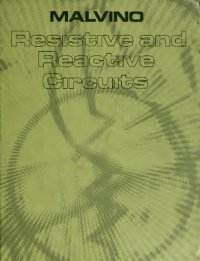
Ebook: Resistive and Reactive Circuits
Author: Albert Paul Malvino
- Tags: electronics circuits electronic
- Year: 1974
- Publisher: Glencoe/McGraw-Hill School Publishing Company
- Language: English
- pdf
The typical dc-ac textbook does a poor job of preparing the technician for
modem electronic courses; too much time is wasted on magnetic circuits,
intricate ac calculations, power-oriented topics, three-phase systems, etc.
The topics that really count, such as Thevenin's theorem, superposition theorem,
resistive ac circuits, etc., get a thin treatment, with almost no follow-up
in succeeding chapters.
To select the right topics for this dc-ac textbook, I used Electronic Principles
as my guide, because it covers the whole field of analog electronics including
bipolars, FETs, ICs, op amps, etc. My reasoning was this: if a dc-ac textbook
prepares a technician to study a modern book like Electronic Principles, then
the technician has learned all the vital dc-ac topics needed for everyday
electronics.
Part 1 of this book is about resistive circuits with dc or ac sources, the special
case so prominent in today's electronics because of direct-coupled circuits.
On completion of this first half of the book, the technician will be ready to
begin a basic electronics course.
Part 2 of this book is about reactive circuits. Chaps. 9 through 12 cover
transients and ac theory without trigonometry, complex numbers, and the
classic phasor approach. Because of this, the reader can cover the first 12
chapters entirely with algebra. These first 12 chapters may be adequate for
many programs that wish to cover practical dc-ac theory without complex
numbers and phasors.
The final part of the book. Chaps. 13 through 18, requires a knowledge of
trigonometry. Here you will find the extensive use of complex numbers and
phasors that typifies in-depth ac analysis. We discuss complex numbers and
phasors in detail; however, trigonometry is assumed as a prerequisite for
Chaps. 13 through 18.
I think you will enjoy the format of this book. It includes two or three key
questions at the beginning of longer topics; these questions are designed to
focus your attention on what's important, to point you in the right direction
before turning you loose. To make sure you understand the key ideas, multiplechoice
tests are included throughout each chapter; the answers to these tests
are at the very end of the chapter.
Many thanks to Lloyd Temes of Staten Island Community College, New York.
He reviewed the manuscript and offered many excellent suggestions.
Albert Paul Malvino
modem electronic courses; too much time is wasted on magnetic circuits,
intricate ac calculations, power-oriented topics, three-phase systems, etc.
The topics that really count, such as Thevenin's theorem, superposition theorem,
resistive ac circuits, etc., get a thin treatment, with almost no follow-up
in succeeding chapters.
To select the right topics for this dc-ac textbook, I used Electronic Principles
as my guide, because it covers the whole field of analog electronics including
bipolars, FETs, ICs, op amps, etc. My reasoning was this: if a dc-ac textbook
prepares a technician to study a modern book like Electronic Principles, then
the technician has learned all the vital dc-ac topics needed for everyday
electronics.
Part 1 of this book is about resistive circuits with dc or ac sources, the special
case so prominent in today's electronics because of direct-coupled circuits.
On completion of this first half of the book, the technician will be ready to
begin a basic electronics course.
Part 2 of this book is about reactive circuits. Chaps. 9 through 12 cover
transients and ac theory without trigonometry, complex numbers, and the
classic phasor approach. Because of this, the reader can cover the first 12
chapters entirely with algebra. These first 12 chapters may be adequate for
many programs that wish to cover practical dc-ac theory without complex
numbers and phasors.
The final part of the book. Chaps. 13 through 18, requires a knowledge of
trigonometry. Here you will find the extensive use of complex numbers and
phasors that typifies in-depth ac analysis. We discuss complex numbers and
phasors in detail; however, trigonometry is assumed as a prerequisite for
Chaps. 13 through 18.
I think you will enjoy the format of this book. It includes two or three key
questions at the beginning of longer topics; these questions are designed to
focus your attention on what's important, to point you in the right direction
before turning you loose. To make sure you understand the key ideas, multiplechoice
tests are included throughout each chapter; the answers to these tests
are at the very end of the chapter.
Many thanks to Lloyd Temes of Staten Island Community College, New York.
He reviewed the manuscript and offered many excellent suggestions.
Albert Paul Malvino
Download the book Resistive and Reactive Circuits for free or read online
Continue reading on any device:

Last viewed books
Related books
{related-news}
Comments (0)